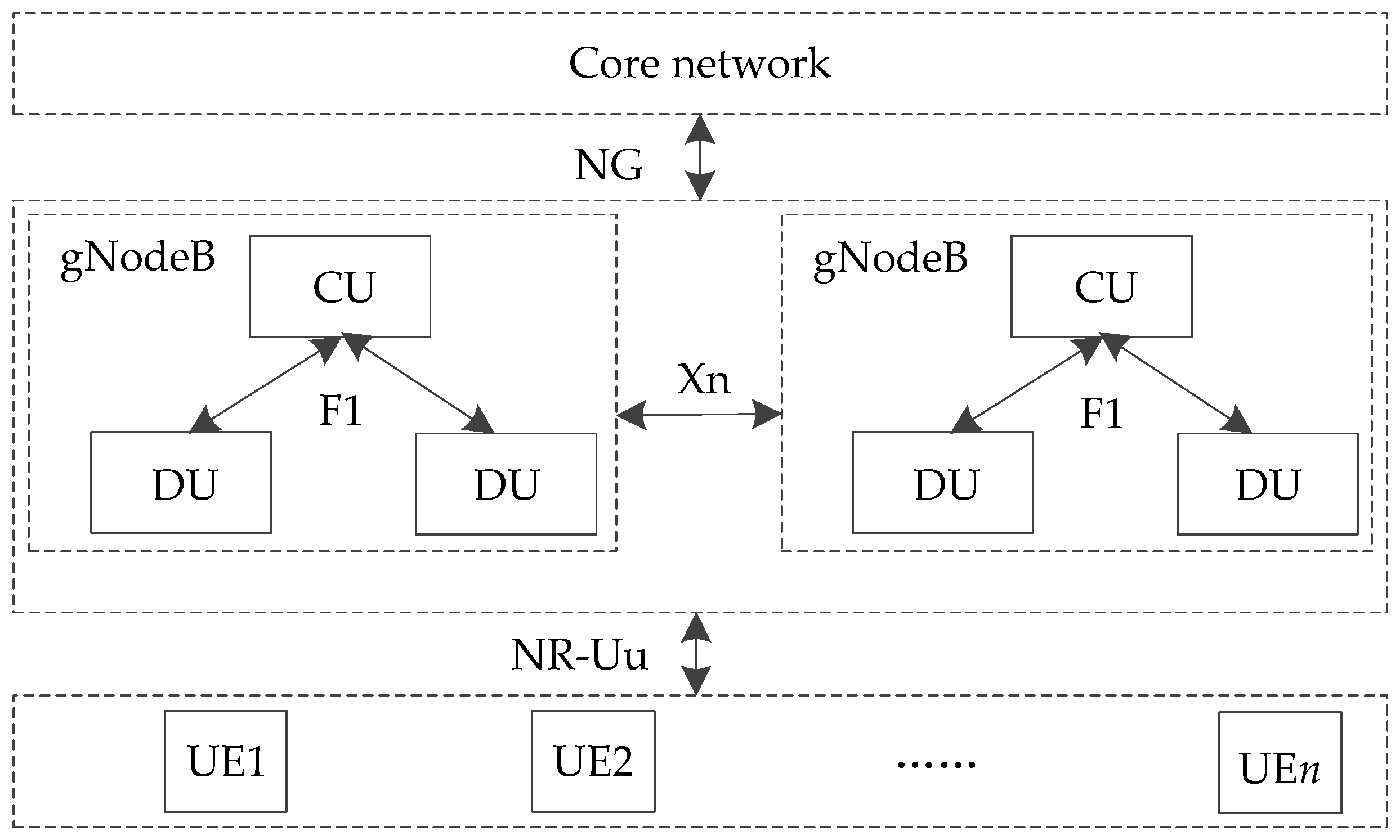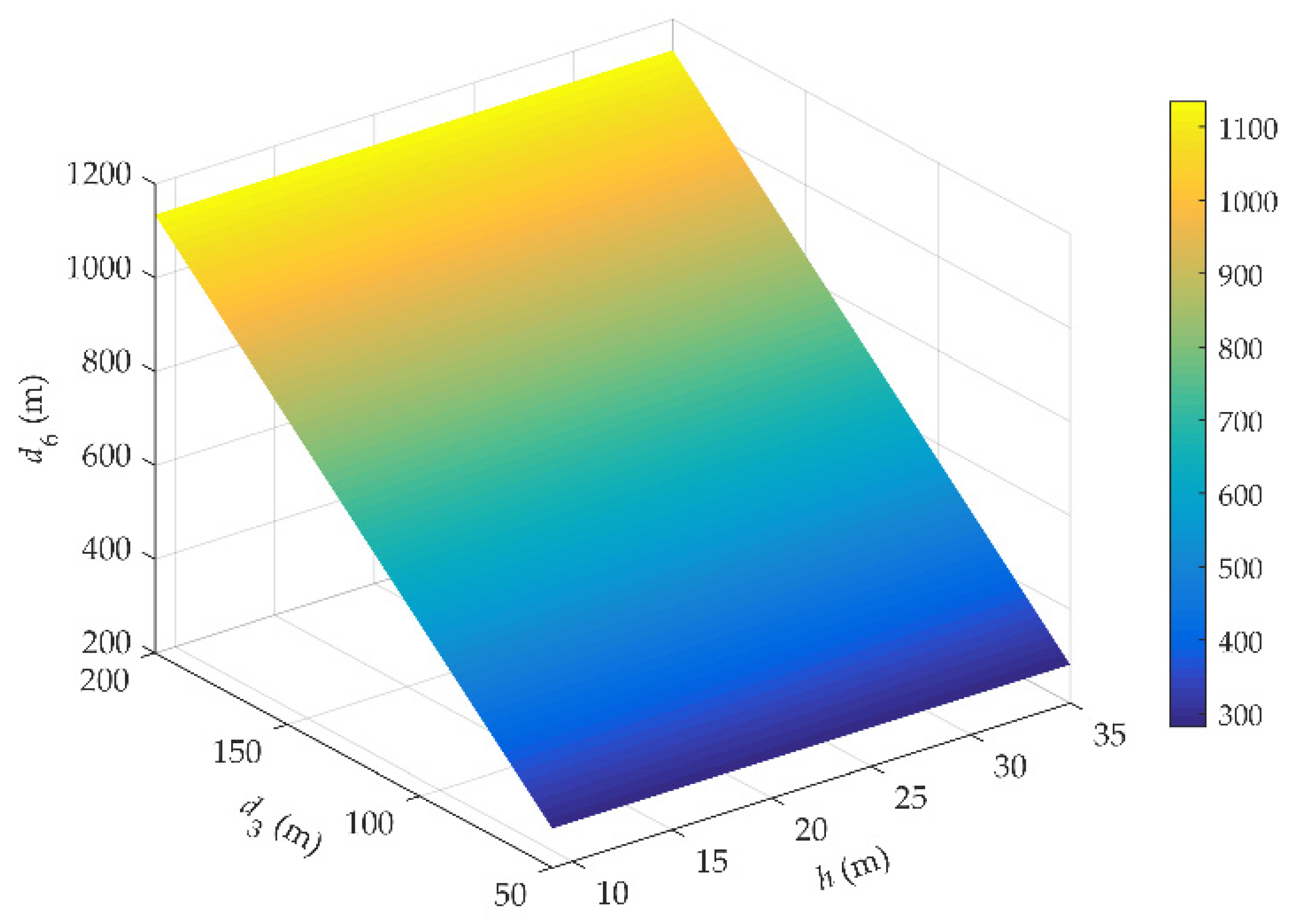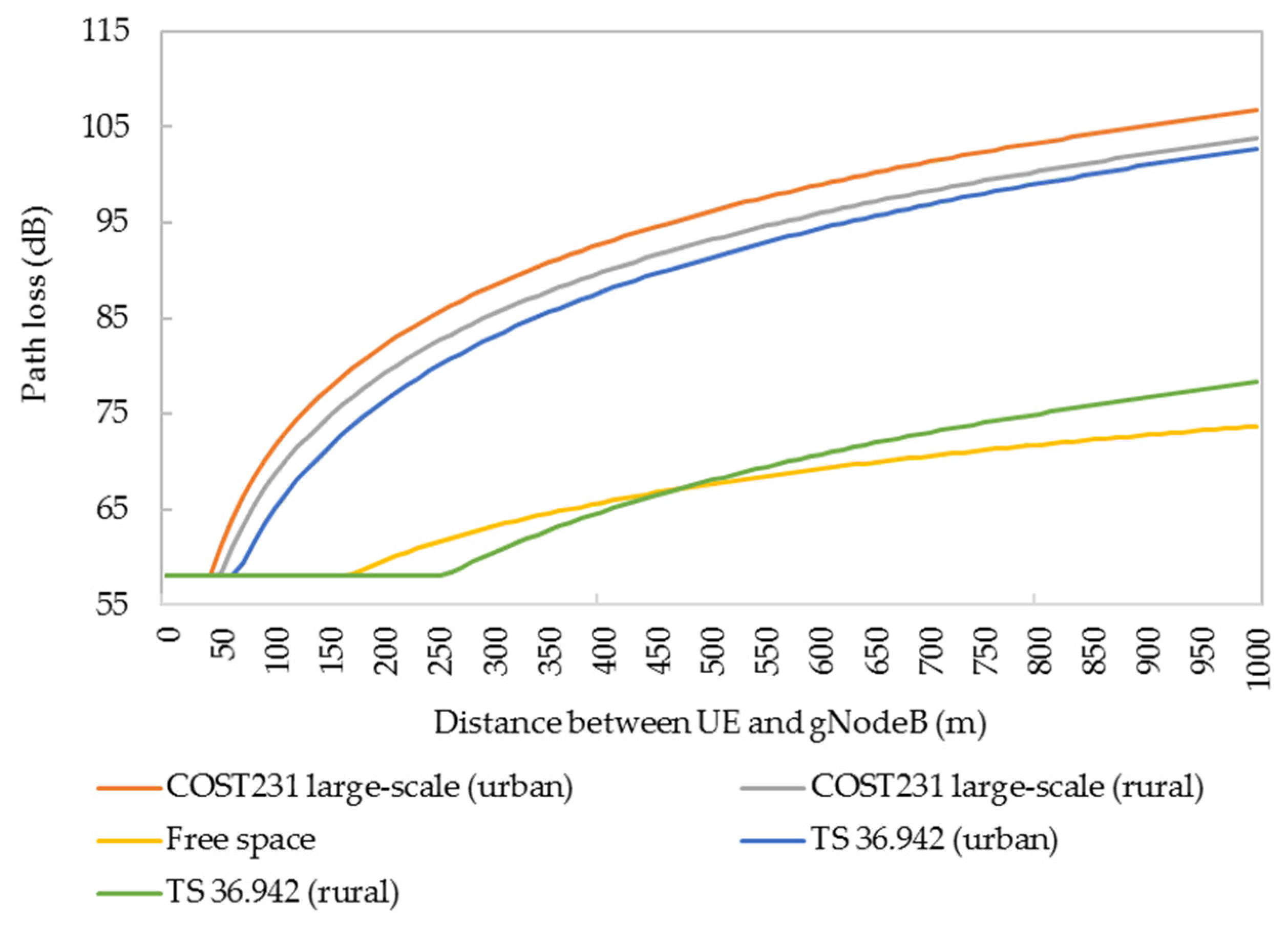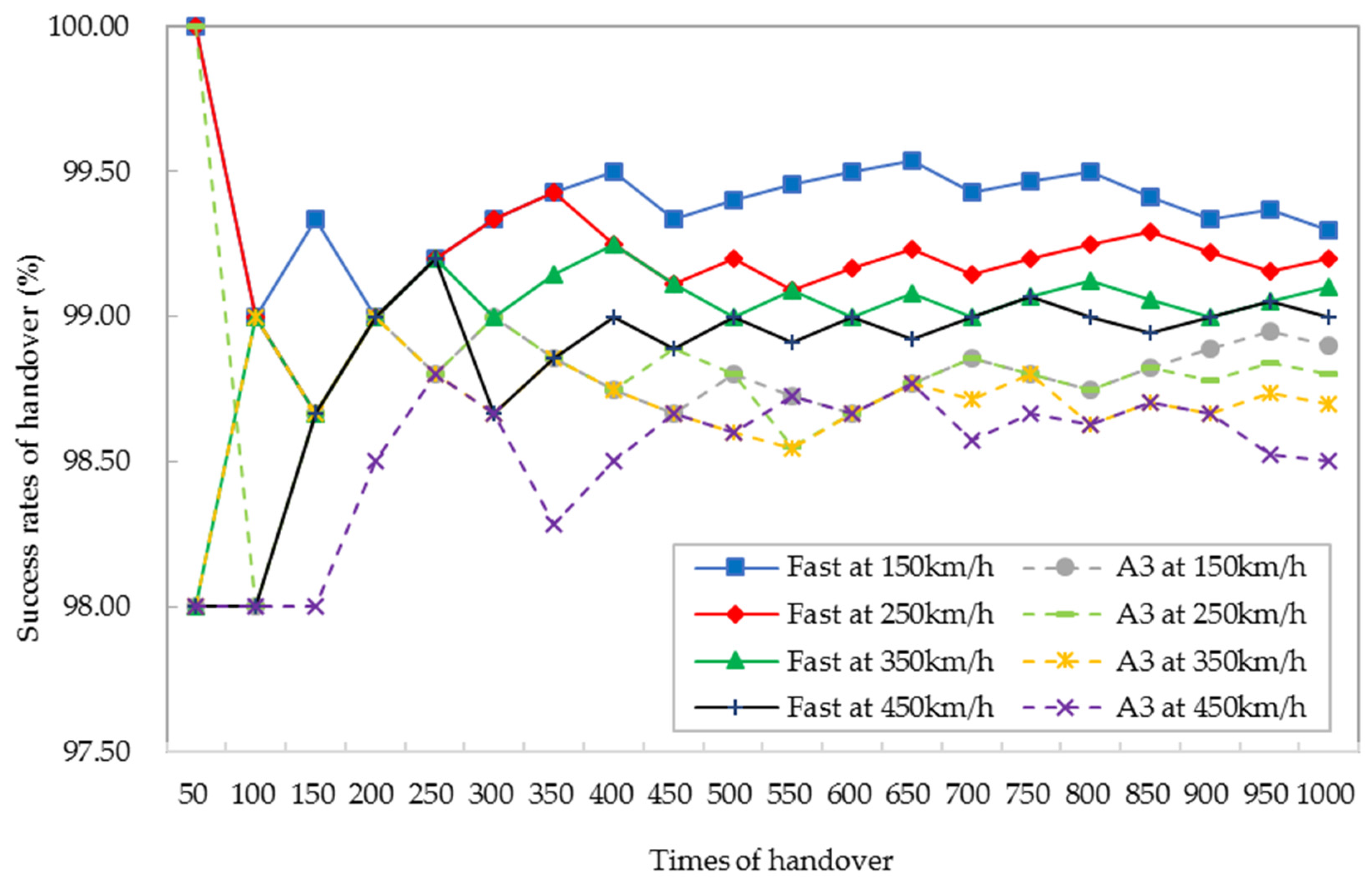Fast Handover Algorithm Based on Location and Weight in 5G-R Wireless Communications for High-Speed Railways
Abstract
1. Introduction
2. G-R for HSRs
2.1. Architecture of Networks
2.2. Planning of the Handover Zone
2.3. Handover Measurement of SCell and NCell
2.3.1. SS-RSRP
2.3.2. SS-RSRQ
2.3.3. Dynamic Hysteresis Margin of SS-RSRP/SS-RSRQ
3. Fast Handover Algorithm
3.1. Analysis of the Feasibility of the Fast Handover Algorithm
3.2. Moving Speed of HST
3.3. Moving Direction of HST
3.4. Process of the Fast Handover Algorithm
3.4.1. Speed Decision
3.4.2. Location Recognition of UE
3.4.3. Weight Calculation of the Handover
4. Experiment and Analysis
4.1. Simulation Parameters
4.2. Simulation Results
5. Conclusions
Author Contributions
Funding
Institutional Review Board Statement
Informed Consent Statement
Data Availability Statement
Acknowledgments
Conflicts of Interest
References
- Geng, Y. Encyclopedia Entry High-Speed Railway for Popularizing Science in China. Available online: https://baike.baidu.com/item/%E9%AB%98%E9%80%9F%E9%93%81%E8%B7%AF/147658?fr (accessed on 17 February 2021).
- He, R.; Ai, B.; Wang, G.; Guan, K.; Zhong, Z.; Molisch, A.F.; Briso-Rodriguez, C.; Oestges, C.P. High-Speed Railway Communications: From GSM-R to LTE-R. IEEE Veh. Technol. Mag. 2016, 11, 49–58. [Google Scholar] [CrossRef]
- Yang, J.; Ai, B.; Salous, S.; Guan, K.; He, D.; Shi, G.; Zhong, Z. An Efficient MIMO Channel Model for LTE-R Network in High-Speed Train Environment. IEEE Trans. Veh. Technol. 2019, 68, 3189–3200. [Google Scholar] [CrossRef]
- Jayaram, P.; Menaka, R. Performance Evaluation of Modified Hybrid Handover Scheme in LTE Fast Moving Rail Networks. Int. J. Wirel. Mob. Comput. 2017, 12, 96–106. [Google Scholar] [CrossRef]
- Xiao, Y.; Qiu, G.; Wang, Y. A Fast Hybrid Beamforming Scheme for High-Speed Railway Communications. Electronics 2019, 8, 998. [Google Scholar] [CrossRef]
- Gozalvez, J. Samsung Electronics Sets 5G Speed Record at 7.5 Gb/s [Mobile Radio]. IEEE Veh. Technol. Mag. 2015, 10, 12–16. [Google Scholar] [CrossRef]
- Yu, X.; Luo, Y.; Chen, X. An Optimized Seamless Dual-Link Handover Scheme for High-Speed Rail. IEEE Trans. Veh. Technol. 2016, 65, 8658–8668. [Google Scholar] [CrossRef]
- Bao, D.; Cui, L.; Jian, X. Design of 5G Wireless Communications in the High-speed Railway Scenario. In Proceedings of the 2020 IEEE 92nd Vehicular Technology Conference, Victoria, BC, Canada, 4–7 October 2020; pp. 1–6. [Google Scholar]
- Hou, Z.; Zhou, Y.; Tian, L.; Shi, J.; Li, Y.; Vucetic, B. Radio Environment Map-Aided Doppler Shift Estimation in LTE Railway. IEEE Trans. Veh. Technol. 2017, 66, 4462–4467. [Google Scholar] [CrossRef]
- Azpilicueta, L.; Astrain, J.; Lopez-Iturri, P.; Granda, F.; Vargas-Rosales, C.; Villadangos, J.; Perallos, A.; Bahillo, A.; Falcone, F. Optimization and Design of Wireless Systems for the Implementation of Context Aware Scenarios in Railway Passenger Vehicles. IEEE Trans. Intell. Transp. Syst. 2017, 18, 2838–2850. [Google Scholar] [CrossRef]
- Ai, B.; He, R.; Li, G.; Guan, K.; He, D.; Shi, G.; Zhong, Z. Determination of Cell Coverage Area and its Applications in High-Speed Railway Environments. IEEE Trans. Veh. Technol. 2017, 66, 3515–3525. [Google Scholar] [CrossRef]
- Ai, B.; Molisch, A.F.; Rupp, M.; Zhong, Z. 5G Key Technologies for Smart Railways. Proc. IEEE 2020, 108, 856–893. [Google Scholar] [CrossRef]
- Song, H.; Fang, X.; Fang, Y. Millimeter-Wave Network Architectures for Future High-Speed Railway Communications: Challenges and Solutions. IEEE Wirel. Commun. 2016, 23, 114–122. [Google Scholar] [CrossRef]
- You, J.; Zhong, Z.D.; Dou, Z.Z.; Dang, J.; Wang, G.P. Wireless Relay Communication on High Speed Railway: Full Duplex or Half Duplex. China Commun. 2016, 13, 14–26. [Google Scholar] [CrossRef]
- Lu, J.; Xiong, K.; Chen, X.; Fan, P. Toward Traffic Patterns in High-Speed Railway Communication Systems: Power Allocation and Access Selection. IEEE Trans. Veh. Technol. 2018, 67, 12273–12287. [Google Scholar] [CrossRef]
- Lu, Y.; Xiong, K.; Fan, P.; Zhong, Z.; Ai, B. The Effect of Power Adjustment on Handover in High-Speed Railway Communication Networks. IEEE Access 2017, 5, 26237–26250. [Google Scholar] [CrossRef]
- Yan, L.; Fang, X.; Fang, Y. A Novel Network Architecture for C/U-Plane Staggered Handover in 5G Decoupled Heterogeneous Railway Wireless Systems. IEEE Trans. Intell. Transp. Syst. 2017, 18, 3350–3362. [Google Scholar] [CrossRef]
- Taheri, M.; Ansari, N.; Feng, J.; Rojas-Cessa, R.; Zhou, M. Provisioning Internet Access Using FSO in High-Speed Rail Networks. IEEE Netw. 2017, 31, 96–101. [Google Scholar] [CrossRef]
- Fathi-Kazerooni, S.; Kaymak, Y.; Rojas-Cessa, R.; Feng, J.; Ansari, N.; Zhou, M.; Zhang, T. Optimal Positioning of Ground Base Stations in Free-Space Optical Communications for High-Speed Trains. IEEE Trans. Intell. Transp. Syst. 2018, 19, 1940–1949. [Google Scholar] [CrossRef]
- Shen, C.; Tekin, C.; Schaar, M. A Non-Stochastic Learning Approach to Energy Efficient Mobility Management. IEEE J. Sel. Areas Commun. 2016, 34, 3854–3868. [Google Scholar] [CrossRef]
- Shen, C.; Schaar, M. A Learning Approach to Frequent Handover Mitigations in 3GPP Mobility Protocols. In Proceedings of the 2017 IEEE Wireless Communications and Networking Conference (WCNC), San Francisco, CA, USA, 19–22 March 2017; pp. 1–6. [Google Scholar]
- Hayashi, M.; Tsunemitsu, Y.; Maeyama, T. Analysis of Penetration Loss of Ultra High Frequency Band Radio Waves on Trains. IEICE Electron. Express 2015, 12. [Google Scholar] [CrossRef]
- Zhang, L.; Rodríguez-Piñeiro, J.; Fernández, J.; García-Naya, J.A.; Matolak, D.W.; Briso, C.; Castedo, L. Propagation Modeling for Outdoor-to-Indoor and Indoor-to-Indoor Wireless Links in High-speed Train. Measurement 2017, 110, 43–52. [Google Scholar] [CrossRef]
- Zhang, Q.; Sun, H.; Feng, Z.; Gao, H.; Li, W. Data-Aided Doppler Frequency Shift Estimation and Compensation for UAVs. IEEE Internet Things J. 2020, 7, 400–415. [Google Scholar] [CrossRef]
- Zhang, C.; Wang, G.; Jia, M.; He, R.; Ai, B. Doppler Shift Estimation for Millimeter-wave Communication Systems on High-speed Railways. IEEE Access 2019, 7, 40454–40462. [Google Scholar] [CrossRef]
- Wu, C.; Wang, Y. Cognitive Communication in Rail Transit: Awareness, Adaption, and Reasoning. IT Prof. 2017, 19, 45–54. [Google Scholar] [CrossRef]
- Wu, C.; Wang, Y.; Yin, Z. Realizing Railway Cognitive Radio: A Reinforcement Base-Station Multi-Agent Model. IEEE Trans. Intell. Transp. Syst. 2019, 20, 452–1467. [Google Scholar] [CrossRef]
- Rojeena, B.; Rakesh, S.; Haejoon, J. Future Is Unlicensed: Private 5G Unlicensed Network for Connecting Industries of Future. Sensors 2020, 20, 2774. [Google Scholar]
- Wang, C.; Ghazal, A.; Ai, B.; Liu, Y.; Fan, P. Channel Measurements and Models for High-speed Train Communication Systems: A Survey. IEEE Commun. Surv. Tutor. 2017, 18, 974–987. [Google Scholar] [CrossRef]
- Duan, B.; Li, C.; Xie, J.; Zhou, D.; Wu, W. Positioning Algorithm Based on the Fingerprint Database by Twice-fuzzy Clustering in the High-speed Railway Scenario. IEEE Access 2020, 8, 64846–64856. [Google Scholar] [CrossRef]
- Hussain, S.M.S.; Aftab, M.A.; Ustun, T.S. Performance Analysis of IEC 61,850 Messages in LTE Communication for Reactive Power Management in Microgrids. Energies 2020, 13, 6011. [Google Scholar] [CrossRef]
- Lai, W.K.; Shieh, C.; Chou, F.; Hsu, C.; Shen, M. Handover Management for D2D Communication in 5G Networks. Appl. Sci. 2020, 10, 4409. [Google Scholar] [CrossRef]
















| Train Number | Data Return Time | Longitude | Latitude | Instantaneous Speed (km/h) |
|---|---|---|---|---|
| D2706 | 9 December 2020 17:06:41 | 97.286705 | 40.104435 | 209.46 |
| 9 December 2020 17:06:42 | 97.287155 | 40.103947 | 239.06 | |
| 9 December 2020 17:06:43 | 97.287613 | 40.103508 | 224.84 | |
| 9 December 2020 17:06:44 | 97.288086 | 40.103127 | 210.33 | |
| 9 December 2020 17:06:45 | 97.288544 | 40.102764 | 201.95 | |
| 9 December 2020 17:06:46 | 97.288933 | 40.102238 | 241.93 | |
| 9 December 2020 17:06:47 | 97.289375 | 40.101746 | 238.98 | |
| 9 December 2020 17:06:48 | 97.289810 | 40.101322 | 215.76 | |
| 9 December 2020 17:06:48 | 97.290268 | 40.100941 | 207.20 |
| Parameters | Value |
|---|---|
| Frequency | 2.6 GHz |
| Bandwidth | 100 MHz |
| nTx/nRx | 4/4 |
| TM | 3 |
| d1 | 1.5 km |
| h | 25 m |
| Antenna mechanical dip angle | 3° |
| Antenna electronic dip angle | 6° |
| Antenna gain | 21.5 dB |
| Minimum coupling loss | 58 dB |
| Vthr | 120 km/h |
| Dthr | 0.9 km |
| α | 0.75 |
| Moving speed of HST | 150/250/350/450 km/h |
Publisher’s Note: MDPI stays neutral with regard to jurisdictional claims in published maps and institutional affiliations. |
© 2021 by the authors. Licensee MDPI, Basel, Switzerland. This article is an open access article distributed under the terms and conditions of the Creative Commons Attribution (CC BY) license (https://creativecommons.org/licenses/by/4.0/).
Share and Cite
Duan, B.; Li, C.; Xie, J.; Wu, W.; Zhou, D. Fast Handover Algorithm Based on Location and Weight in 5G-R Wireless Communications for High-Speed Railways. Sensors 2021, 21, 3100. https://doi.org/10.3390/s21093100
Duan B, Li C, Xie J, Wu W, Zhou D. Fast Handover Algorithm Based on Location and Weight in 5G-R Wireless Communications for High-Speed Railways. Sensors. 2021; 21(9):3100. https://doi.org/10.3390/s21093100
Chicago/Turabian StyleDuan, Baofeng, Cuiran Li, Jianli Xie, Wei Wu, and Dongmei Zhou. 2021. "Fast Handover Algorithm Based on Location and Weight in 5G-R Wireless Communications for High-Speed Railways" Sensors 21, no. 9: 3100. https://doi.org/10.3390/s21093100
APA StyleDuan, B., Li, C., Xie, J., Wu, W., & Zhou, D. (2021). Fast Handover Algorithm Based on Location and Weight in 5G-R Wireless Communications for High-Speed Railways. Sensors, 21(9), 3100. https://doi.org/10.3390/s21093100






